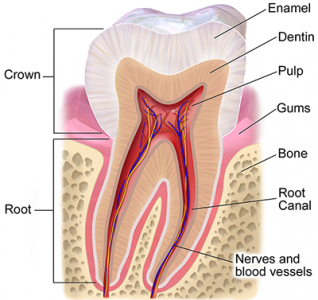A CBR research team led by Professor Chris Overall (www.clip.ubc.ca) recently published a study focused on human dental pulp (Eckhard et al, J. Proteome Research, 2015)1. This study reports the most comprehensive snapshot of any dental tissue so far, and was featured in the Editorial of the Human Proteome Project Special Issue published by the Journal of Proteome Research for the HUPO-2015 world congress.
The dental pulp, commonly known as “nerve” of the tooth is enclosed within the mineralized outer covering of the tooth. By using contemporary mass spectrometry technology, the researchers identified more than 4,300 proteins, representing nearly 22% of all predicted human proteins, including 17 that have never been observed experimentally before. Over 9,000 cut protein ends (termini) were identified, indicating that protease activity is prevalent in healthy pulp.
For many years, studies have focused on the role of proteases as non-selective protein degraders. However, over the last 15 years, Prof. Overall and his laboratory have pioneered the idea that proteases can act as sharp and highly specific scissors, precisely processing proteins rather than just degrading them. Such finely tuned proteolytic processing generates new protein products with altered protein termini that can turn protein activity on or off to regulate whole signaling cascades, or induce different protein functions and changed localization in cells and tissues. These key regulatory roles put proteases and their action in the driving seat of many biological processes in health and disease.
To investigate how proteases modulate homeostasis and pathogenesis, the Overall Lab first used healthy human tissues, such as platelets2, erythrocytes3, and now dental pulp1 to capture human protein termini to build a solid understanding of proteolytic processing in health. Thereby the lab actively participates in the Chromosome-centric Human Proteome Project (C-HPP; www.c-hpp.org), a global initiative designed by the Human Proteome Organization (www.hupo.org) to map the human proteome (every single gene-encoded protein in the human body) – a quest that began as soon as the Human Genome Project was completed in 2003. Research teams around the world are trying to describe the structure and function of the human proteome and its changes upon disease.
The next stage is to analyze disease samples to identify disruptions in proteolytic processing and signaling that may cast light on new drug targets. Dental pulps from healthy teeth will be compared with pulps from teeth with various degrees of tooth decay to identify key drivers of caries and potential drug candidates to promote tooth repair. In parallel, human gum tissue will be used to study periodontitis, a common gum infection that damages the soft tissue and destroys the bone that supports the tooth, ultimately leading to tooth loss. With this research, the Overall lab is at the forefront of protease-focused health research aimed at improving the lives of millions of Canadians and decreasing the financial burden of inflammatory diseases on Canada’s health system.




